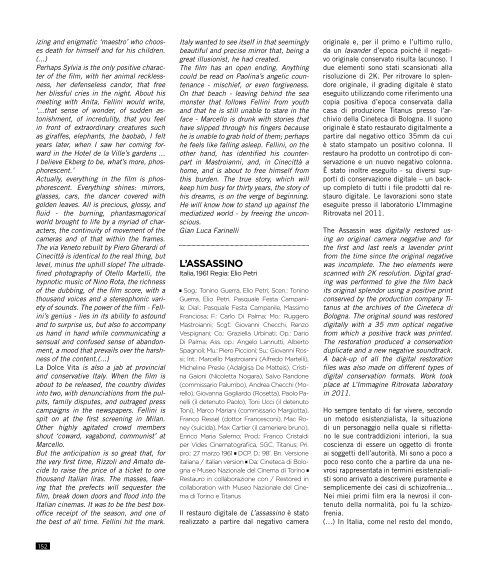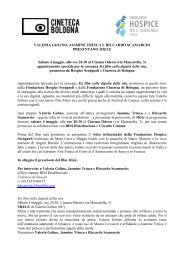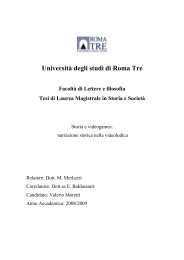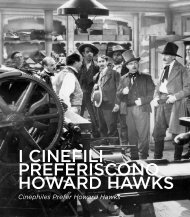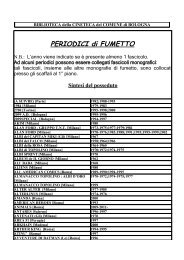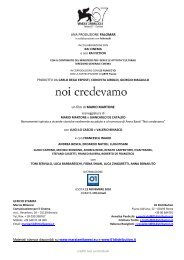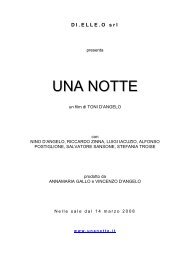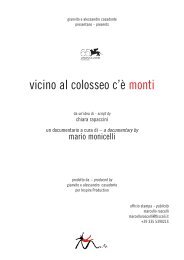Ritrovati & Restaurati sonori.pdf - Cineteca di Bologna
Ritrovati & Restaurati sonori.pdf - Cineteca di Bologna
Ritrovati & Restaurati sonori.pdf - Cineteca di Bologna
Create successful ePaper yourself
Turn your PDF publications into a flip-book with our unique Google optimized e-Paper software.
izing and enigmatic ‘maestro’ who chooses<br />
death for himself and for his children.<br />
(...)<br />
Perhaps Sylvia is the only positive character<br />
of the film, with her animal recklessness,<br />
her defenseless candor, that free<br />
her blissful cries in the night. About his<br />
meeting with Anita, Fellini would write,<br />
‘...that sense of wonder, of sudden astonishment,<br />
of incredulity, that you feel<br />
in front of extraor<strong>di</strong>nary creatures such<br />
as giraffes, elephants, the baobab, I felt<br />
years later, when I saw her coming forward<br />
in the Hotel de la Ville’s gardens ...<br />
I believe Ekberg to be, what’s more, phosphorescent.’<br />
Actually, everything in the film is phosphorescent.<br />
Everything shines: mirrors,<br />
glasses, cars, the dancer covered with<br />
golden leaves. All is precious, glossy, and<br />
fluid - the burning, phantasmagorical<br />
world brought to life by a myriad of characters,<br />
the continuity of movement of the<br />
cameras and of that within the frames.<br />
The via Veneto rebuilt by Piero Gherar<strong>di</strong> of<br />
Cinecittà is identical to the real thing, but<br />
level, minus the uphill slope! The ultradefined<br />
photography of Otello Martelli, the<br />
hypnotic music of Nino Rota, the richness<br />
of the dubbing, of the film score, with a<br />
thousand voices and a stereophonic variety<br />
of sounds. The power of the film - Fellini’s<br />
genius - lies in its ability to astound<br />
and to surprise us, but also to accompany<br />
us hand in hand while communicating a<br />
sensual and confused sense of abandonment,<br />
a mood that prevails over the harshness<br />
of the content.(...)<br />
La Dolce Vita is also a jab at provincial<br />
and conservative Italy. When the film is<br />
about to be released, the country <strong>di</strong>vides<br />
into two, with denunciations from the pulpits,<br />
family <strong>di</strong>sputes, and outraged press<br />
campaigns in the newspapers. Fellini is<br />
spit on at the first screening in Milan.<br />
Other highly agitated crowd members<br />
shout ‘coward, vagabond, communist’ at<br />
Marcello.<br />
But the anticipation is so great that, for<br />
the very first time, Rizzoli and Amato decide<br />
to raise the price of a ticket to one<br />
thousand Italian liras. The masses, fearing<br />
that the prefects will sequester the<br />
film, break down doors and flood into the<br />
Italian cinemas. It was to be the best boxoffice<br />
receipt of the season, and one of<br />
the best of all time. Fellini hit the mark.<br />
152<br />
Italy wanted to see itself in that seemingly<br />
beautiful and precise mirror that, being a<br />
great illusionist, he had created.<br />
The film has an open en<strong>di</strong>ng. Anything<br />
could be read on Paolina’s angelic countenance<br />
- mischief, or even forgiveness.<br />
On that beach - leaving behind the sea<br />
monster that follows Fellini from youth<br />
and that he is still unable to stare in the<br />
face - Marcello is drunk with stories that<br />
have slipped through his fingers because<br />
he is unable to grab hold of them; perhaps<br />
he feels like falling asleep. Fellini, on the<br />
other hand, has identified his counterpart<br />
in Mastroianni, and, in Cinecittà a<br />
home, and is about to free himself from<br />
this burden. The true story, which will<br />
keep him busy for thirty years, the story of<br />
his dreams, is on the verge of beginning.<br />
He will know how to stand up against the<br />
me<strong>di</strong>atized world - by freeing the unconscious.<br />
Gian Luca Farinelli<br />
L’ASSASSINO<br />
Italia, 1961 Regia: Elio Petri<br />
█ Sog.: Tonino Guerra, Elio Petri; Scen.: Tonino<br />
Guerra, Elio Petri, Pasquale Festa Campanile;<br />
Dial.: Pasquale Festa Campanile, Massimo<br />
Franciosa; F.: Carlo Di Palma; Mo.: Ruggero<br />
Mastroianni; Scgf.: Giovanni Checchi, Renzo<br />
Vespignani; Co.: Graziella Urbinati; Op.: Dario<br />
Di Palma; Ass. op.: Angelo Lannutti, Alberto<br />
Spagnoli; Mu.: Piero Piccioni; Su.: Giovanni Rossi;<br />
Int.: Marcello Mastroianni (Alfredo Martelli),<br />
Micheline Presle (Adalgisa De Matteis), Cristina<br />
Gaioni (Nicoletta Nogara), Salvo Randone<br />
(commissario Palumbo), Andrea Checchi (Morello),<br />
Giovanna Gagliardo (Rosetta), Paolo Panelli<br />
(il detenuto Paolo), Toni Ucci (il detenuto<br />
Toni), Marco Mariani (commissario Margiotta),<br />
Franco Ressel (dottor Francesconi), Mac Roney<br />
(suicida), Max Cartier (il cameriere bruno),<br />
Enrico Maria Salerno; Prod.: Franco Cristal<strong>di</strong><br />
per Vides Cinematografica, SGC, Titanus; Pri.<br />
pro.: 27 marzo 1961 █ DCP. D.: 98’. Bn. Versione<br />
italiana / Italian version █ Da: <strong>Cineteca</strong> <strong>di</strong> <strong>Bologna</strong><br />
e Museo Nazionale del Cinema <strong>di</strong> Torino █<br />
Restauro in collaborazione con / Restored in<br />
collaboration with Museo Nazionale del Cinema<br />
<strong>di</strong> Torino e Titanus<br />
Il restauro <strong>di</strong>gitale de L’assassino è stato<br />
realizzato a partire dal negativo camera<br />
originale e, per il primo e l’ultimo rullo,<br />
da un lavander d’epoca poiché il negativo<br />
originale conservato risulta lacunoso. I<br />
due elementi sono stati scansionati alla<br />
risoluzione <strong>di</strong> 2K. Per ritrovare lo splendore<br />
originale, il gra<strong>di</strong>ng <strong>di</strong>gitale è stato<br />
eseguito utilizzando come riferimento una<br />
copia positiva d’epoca conservata dalla<br />
casa <strong>di</strong> produzione Titanus presso l’archivio<br />
della <strong>Cineteca</strong> <strong>di</strong> <strong>Bologna</strong>. Il suono<br />
originale è stato restaurato <strong>di</strong>gitalmente a<br />
partire dal negativo ottico 35mm da cui<br />
è stato stampato un positivo colonna. Il<br />
restauro ha prodotto un controtipo <strong>di</strong> conservazione<br />
e un nuovo negativo colonna.<br />
È stato inoltre eseguito - su <strong>di</strong>versi supporti<br />
<strong>di</strong> conservazione <strong>di</strong>gitale – un backup<br />
completo <strong>di</strong> tutti i file prodotti dal restauro<br />
<strong>di</strong>gitale. Le lavorazioni sono state<br />
eseguite presso il laboratorio L’Immagine<br />
Ritrovata nel 2011.<br />
The Assassin was <strong>di</strong>gitally restored using<br />
an original camera negative and for<br />
the first and last reels a lavender print<br />
from the time since the original negative<br />
was incomplete. The two elements were<br />
scanned with 2K resolution. Digital gra<strong>di</strong>ng<br />
was performed to give the film back<br />
its original splendor using a positive print<br />
conserved by the production company Titanus<br />
at the archives of the <strong>Cineteca</strong> <strong>di</strong><br />
<strong>Bologna</strong>. The original sound was restored<br />
<strong>di</strong>gitally with a 35 mm optical negative<br />
from which a positive track was printed.<br />
The restoration produced a conservation<br />
duplicate and a new negative soundtrack.<br />
A back-up of all the <strong>di</strong>gital restoration<br />
files was also made on <strong>di</strong>fferent types of<br />
<strong>di</strong>gital conservation formats. Work took<br />
place at L’Immagine Ritrovata laboratory<br />
in 2011.<br />
Ho sempre tentato <strong>di</strong> far vivere, secondo<br />
un metodo esistenzialista, la situazione<br />
<strong>di</strong> un personaggio nella quale si riflettano<br />
le sue contrad<strong>di</strong>zioni interiori, la sua<br />
coscienza <strong>di</strong> essere un oggetto <strong>di</strong> fronte<br />
ai soggetti dell’autorità. Mi sono a poco a<br />
poco reso conto che a partire da una nevrosi<br />
rappresentata in termini esistenzialisti<br />
sono arrivato a descrivere puramente e<br />
semplicemente dei casi <strong>di</strong> schizofrenia...<br />
Nei miei primi film era la nevrosi il contenuto<br />
della normalità, poi fu la schizofrenia.<br />
(…) In Italia, come nel resto del mondo,


